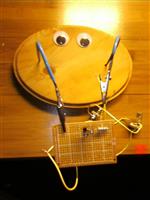
I'm designing some hardware using EasyEDA. I'm planning to do the PCB and SMD assembly. I just got my first print last week, and i'm very happy with the price and quality.
My current design features a Arduino mega on a PCB with a 3" OLED, some LED,s chips, and expansion ports. I need to power the circuit with 11~15V from a car battery, and am looking to use a more efficient regulator than the AMS1117 on the Arduino.
So i want to convert 11 to 16V to 5V, and i'm targeting a current usage between 200mA and 1A (the 1A is for future expansions)
The manufacturer SMT service has a very limited list of basic components, and i want to prevent extra charges from their extended library. I made quick evaluation of the available types below:
So i wanted to go with the last one. I played around with their great design tool, but i can really get the efficiency above 88%. This means i hit the maximum dissipation of the SOT-23-6 package before i get to 1A. This may be acceptable, but i rather go up to 1A and don't love the idea of the component working at its maximum dissipation.
I'm kind of getting the idea that it is not realistic getting getting more than 1A out of SOT-23 or SOIC-8 package buck converter. Is this true, or am i doing something wrong here?
Which regulator from the list would you pick?
This will also be the first time i work with coils. How does choosing a higher or lower uH effect the efficiency of a buck converter? I understand the advantage of a higher current coil, and a lower DC resistance.
But what is a smart SMD package size to choose? There are so many options here.
By the way, i'm also trying to keep the BOM costs low, as i may want to bring this product to market. That is why i did not choose the LM2576.
Also while on the subject; Is there a reason all Arduinos use linear regulators? Are there disadvantages to supplying the 5V pin with a buck regulator?
- Comments(1)
A****min
Mar 18.2020, 14:46:46
Don't look at just the price of the switching regulator IC.
Look also at the components they need to work.
Some inductors are more expensive than others, some are cheaper. Often an IC may cost you a few cents more but it may run at higher frequency so you can use a smaller and cheaper surface mount inductor, or that regulator doesn't require some ceramic resistors and/or capacitors that others do need) so overall you're saving money.
Also look into the total area used by the whole circuit.
They use linear regulators because they're basically a single chip, only needs maybe an input and output capacitor. Switching regulators often require an inductor, an extra diode etc all these add up to the cost.
There's something to think about in switching regulators may be more noisy so the ADC performance could be affected a bit, but cheap linear regulators don't filter well whatever crap psu most noobies use to power the board.
Also pay attention to description and information and recommendations in datasheets when it comes to inductors and specifications for inductors and filtering capacitors ... they definitely affect efficiency and badly chosen components can even cause oscillations or issues from time to time.
Linear regulators aren't excepted, especially the 1117 linear regulators. For example, most 1117 regulators require a capacitor on the output which ESR between 0.1 ohm and 1 ohm, otherwise they output can go bad. Some datasheets even go so far as to recommend 0.3 ..1 ohm .... so ceramic capacitors are not recommended, unless you add a resistor in series with the ceramic capacitor.


